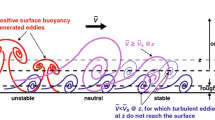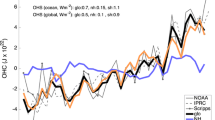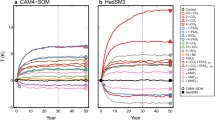Summary
The annual and seasonal cycle of the global zonally averaged storage and transport of moist static energy (MSE), the surface eddy flux of MSE, and the radiation budget at the top of the atmosphere (TOA) and surface are investigated in this paper. We use the GFDL (Geophysical Fluid Dynamics Laboratory) zonal mean data to compute the storage rate, divergence, and poleward flux of MSE. Surface eddy fluxes are determined based on an empirical formula developed from available climatological data. Radiative fluxes at the TOA and surface are computed from a radiation model. A number of significant features are illustrated by the present analysis in regard to the global annual and seasonal energy balance of the earth-atmosphere system. The storage/release rate of MSE is greater in spring and autumn than in summer and winter. The rate of poleward transport of MSE has a maximum at ~40°N and ~35°S with a value of ~3 × 1015 W. In terms of the radiation budget, the persistent ITCZ minimum and subtropical maxima of the IR flux distribution are reproduced well in the radiation parameterization program. The incoming solar flux maximum shifts from ~20°N in spring to ~40°N in summer due to the poleward increase in the fraction of daytime. Finally, an examination of the global surface energy balance reveals that the surface net fluxes derived from parameterizations for eddy and radiative fluxes agree well with values derived from observations. This agreement appears to imply that on the global mean, the physical parameterizations used in the present study are reliable in modeling the seasonal surface flux components.
Zusammenfassung
Der jährliche und jahreszeitliche Gang der globalen Zonenmittel der Speicherung und des Transports von latenter Energie (MSE), des Oberflächen-Eddy-Flusses der MSE und des Einstrahlungsbudgets an der Atmosphärengrenze (TOA) als auch auf der Erdoberfläche werden untersucht.
Wir verwenden die GFDL Zonenmitteldaten, um die Ladung, Divergenz und den polgerichteten Fluß der MSE zu errechnen. Die Oberflächen-Eddy-Flüsse werden aufgrund einer empirischen Formel bestimmt, die mittels verfügbarer klimatologischer Daten erstellt wurde. Strahlungsflüsse auf der Oberfläche und der Atmosphärengrenze werden mittels eines Einstrahlungsmodells errechnet. Eine Reihe signifikanter Erscheinungen werden in der vorliegenden Analyse dargestellt mit Hinblick auf das globale jährliche und jahreszeitliche Energiegleichgewicht des Erde-Atmosphäre-Systems. Die Ladungs- und Entladungsrate des MSE ist im Frühjahr und Herbst größer als im Sommer und Winter. Die Spitzen des polgerichteten Transports der MSE liegen bei 40° N und 35° S mit einem Wert von ca. 3 × 1015 W. In bezug auf das Einstrahlungsbudget werden die persistenten ITKZ-Minima und die subtropischen Maxima der IR-Flußverteilung gut von dem Einstrahlungsparameterisierungsprogramm dargestellt. Die Sonneneinstrahlungsflußspitzen verschieben sich von 20° N im Frühjahr nach 40° im Sommer aufgrund der gegen den Pol hin zunehmenden Tageslänge. Zuletzt zeigen die Untersuchungen des globalen Oberflächenenergiegleichgewichts auf, daß die Oberflächennettoflüsse, abgeleitet von der Parameterisierung für Eddy- und Einstrahlungsflüsse, mit den beobachteten Werten gut übereinstimmen. Diese Übereinstimmung impliziert offensichtlich, daß im globalen Durchschnitt die physikalische Parametrisierung, die in dieser Studie angewendet wurde, verläßliche Modelle der jahreszeitlichen Oberflächenflußkomponenten liefern kann.
Similar content being viewed by others
References
Budyko, M. I., 1982:The Earth's Climate: Past and Future. New York: Academic Press, 307 pp.
Howard, J. N., King, J. I. F., Gast, P. R., 1961: Thermal radiation. In:Handbook of Geophysics, New York: MacMillan, Chapter 16. 964 pp.
Liou, K. N., Ou, S. S., 1983: Theory of equilibrium temperature in radiative turbulent atmospheres.J. Atmos. Sci. 40, 215–229.
Liou, K. N., Ou, S. S., Kinne, S., Koenig, G., 1984: Radiation parameterization programs for general circulation models. Air Force Geophysics Laboratory, AFGL-TR-84-0217, 53 pp.
Liou, K. N., Sasamori, T., 1975: On the transfer of solar radiation in aerosol atmospheres.J. Atmos. Sci. 32, 2166–2177.
Liou, K. N., Wittman, G. D., 1979: Parameterization of the radiative properties of clouds.J. Atmos. Sci. 36, 1261–1273.
London, J., 1957: A study of the atmospheric heat balance. Final Report, Contract AF 19 (122)–165 (AFCRC-TR-57-287), New York University [ASTIN 117227], 99 pp.
Manabe, S., Möller, F., 1961: On the radiative equilibrium and heat balance of the atmosphere.Mon. Wea. Rev. 89, 503–552.
McClatchey, R. A., Fenn, R. W., Selby, J. E. A., Voltz, F. E., Garing, J. S., 1971: Optical properties of the atmosphere. AFCRL Environmental Research Papers, No. 354, 85 pp.
Oort, A. H., 1983:Global Atmospheric Circulation Statistics, 1958–1973. NOAA Prof. Paper 14, U.S. Dept. of Commerce, 180 pp.
Oort, A. H., Péixoto, J. P., 1983: Global angular momentum and energy balance requirements from observations.Adv. Geophys., 25,Theory of Climate, New York: Academic Press, 355–505.
Oort, A. H., Rasmusson, E. M., 1971:Atmospheric Circulation Statistics. NOAA Prof. Paper 5, U.S. Dept. of Commerc, 323 pp.
Oort, A. H., Vonder Haar, T. H., 1976: On the observed annual cycle in the ocean-atmosphere heat balance over the Northern Hemisphere.J. Phys. Oceanogr. 6, 781–800.
Ou, S. S., Liou, K. N., 1983: Parameterization of carbon dioxide 15 µm band absorption and emission.J. Geophys. Res. 88, 5203–5207.
Ou, S. S., Liou, K. N., 1984: A two-dimensional radiativeturbulent climate model. I: Sensitivity to cirrus radiative properties.J. Atmos. Sci. 41, 2289–2309.
Robock, A., 1980: The seasonal cycle of snow cover, sea ice, and surface albedo.Mon. Wea. Rev. 108, 267–285.
Sasamori, T., London, J., Hoyt, D. V., 1972: Radiation budget of the Southern Hemisphere. In:Meteorology of the Southern Hemisphere, Meteor. Mongr., 13, 263 pp.
Sellers, W. D., 1965:Physical Climatology. University of Chicago Press, 272 pp.
Stephens, G. L., Campbell, G. C., Vonder Haar, T. H., 1981: Earth radiation budgets.J. Geophys. Res. 86, 9739–9760.
Vonder Haar, T. H., Suomi, V. E., 1971: Measurements of the earth's radiation budget from satellites during a five-year period. Part I: Extended time and space means.J. Atmos. Sci. 38, 305–314.
Author information
Authors and Affiliations
Additional information
With 8 Figures
Rights and permissions
About this article
Cite this article
Ou, Sc.S., Liou, K.N. & Liou, W.J. The seasonal cycle of the global zonally averaged energy balance. Theor Appl Climatol 40, 9–23 (1989). https://doi.org/10.1007/BF00867788
Received:
Revised:
Issue Date:
DOI: https://doi.org/10.1007/BF00867788




